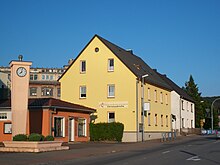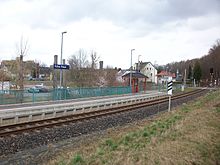Plaue-Bernsdorf
|
Plaue-Bernsdorf
City of Flöha
Coordinates: 50 ° 50 ′ 55 " N , 13 ° 4 ′ 44" E
|
||
|---|---|---|
| Residents : | 3960 (1950) | |
| Incorporation : | January 1, 1962 | |
| Postal code : | 09557 | |
| Area code : | 03726 | |
|
Location of Plaue-Bernsdorf in Saxony |
||
Plaue and Bernsdorf are two parts of the municipality of the large district town of Flöha in the Saxon district of central Saxony . They were mentioned together as Plaue-Bernsdorf since the end of the 19th century and in 1939 they were renamed “Plaue”. They have been part of Flöha as a district since 1962.
geography
The places Plaue and Bernsdorf are on the edge of the lower Eastern Ore Mountains south of the town of Flöha. The Zschopau separates the two districts from each other. Plaue is on the right bank, Bernsdorf on the left bank. Neighboring places of Plaue-Bernsdorf are Flöha in the north, Falkenau and its part of the municipality Hetzdorf in the east, Erdmannsdorf in the south and Chemnitz-Euba in the west.
history
13-18 century
The founding of the places in the area where the Flöha flows into the Zschopau was probably made around 1200 by Rhine-Franconian or Flemish farmers. The two Waldhufendörfer were first mentioned in 1368 for Bernsdorf as "Bernerstorf" and in 1378 for Plaue as "Plawe". The mill in Bernsdorf was also mentioned for the first time in 1378, the saddle in 1390. The limestone caves in the Schweddey were mentioned in 1453. Flood disasters prevented the four villages Flöha and Gückelsberg in the north with Plaue and Bernsdorf in the south from growing together at the mouth of the Flöha .
As part of the Albertine Duchy of Saxony, Plaue and Bernsdorf introduced the Reformation in 1539 and thereby became Protestant. As a result of a reorganization of the administration, Plaue and Bernsdorf, as well as their northern neighbor Flöha, from 1551 belonged as official villages to the office Schellenberg, which in 1590 was renamed " Amt Augustusburg ". In 1579 the villages of Flöha and Plaue signed a bridge contract for the joint maintenance of the church bridge in Flöha. Around 1580 there were three bridges in the Flöha area: the Landbrücke, the Flöha Church Bridge and the Zschopau Bridge in Plaue. In 1619 Plaue and Bernsdorf were jointly assessed on the basis of hereditary interest and free money, which could indicate an administrative community. Ecclesiastically, Plaue was parish to Flöha, Bernsdorf to Erdmannsdorf. In 1770 the school affiliation of the Bernsdorf children changed from the Erdmannsdorf school to Plaue. Around 1780 the settlement area of Plaue expanded from the market between Zschopau and Mühlgraben, along the Wehrstraße and from the market to the Kohlwiese.
19th century to the present
At the beginning of the 19th century, the agricultural areas around Flöha developed into modern industrial areas. In 1809 the first cotton spinning mill was founded in Bernsdorf. The meadow on which the spinning mill was built was initially called "Kirchwiese" and actually belonged to the Flöhaer Flur. In 1580 the Elector of Saxony bought it and built a raft place, a wood cutting mill with a mill and a coal pile for silver mining in Freiberg , which made the Kirchwiese “Kohlwiese” since then. After Benjamin Pflugbeil had acquired the Kohlwiese in 1789, he had a bleaching and dyeing plant built on it, which has made the meadow "the bleach" ever since. In 1809 Seeber founded the first cotton spinning mill in Bernsdorf auf der Bleiche. In 1816 it was taken over by the brothers Peter Otto and Ernst Iselin Clauss. It was not until 1845 that the Flöhaer Kohlwiese was added to Bernsdorf after nine years of negotiations due to a certain customary law.
Plaue and Bernsdorf were named together from the 19th century. As a result of the Saxon rural community code , a community council was elected by the villagers for the first time in 1839. In 1856 the jurisdiction of the place was transferred to the court office of Augustusburg . Since 1874 Plaue-Bernsdorf has belonged to the newly founded Amtshauptmannschaft Flöha , from 1876 the administrative headquarters of the Amtshauptmannschaft was in Plaue. The Chemnitz-Annaberg (Zschopautalbahn) line , which was opened in 1866 and whose tracks led through Plaue-Bernsdorf, brought an economic upturn . With the Dresden – Werdau railway line opened in 1869 , the nearby Flöha station became a railway junction.
At the end of the 19th century, new businesses sprang up in quick succession, including the Robert Wilisch colored paper factory (1878) and the Carl Siems tulle factory (1898). In 1877 the Plaue-Bernsdorf volunteer fire brigade was founded , which has provided fire protection and general assistance ever since . By surrounding Flöha, Schweddey has been a district of Plaue-Bernsdorf since 1899. In the following year, the development of the Plauberg began. In 1909 street names were introduced in Plaue-Bernsdorf. In 1922 the "Gendarmeriesidelung" was established in Bernsdorf, which was later renamed "Waldsiedlung". The first Saxon concentration camp was set up on March 9, 1933 in a gym in Plaue. The Plaue concentration camp existed until June 10, 1933. In Plaue, the peripheral settlement between the railway line to Annaberg and Augustusburger Strasse was built in 1936. The Sachsen-, Anton-Günter-, Süd- and Wilhelm-Külz-Straße were built up until 1939. In 1939 the rural community “Plaue-Bernsdorf” was renamed “Plaue”.
After the Second World War , large companies in Saxony were expropriated without compensation in 1946. In Plaue this affected u. a. the "cotton spinning and twisting mill EJ Clauß Nachf." and the "Buntpapierfabrik Robert Wilisch", which were later converted into state or state-owned companies. As a result of the land reform in the GDR , the saddles in the Bernsdorf district were expropriated without compensation and distributed to land arms or new farmers . In 1951 the church of Plaue was named "Ev.-Luth. Resurrection Church Flöha-Plaue ”independently. On January 1, 1962, the community Plaue was incorporated into the city of Flöha as "Flöha-Süd". It had been part of the newly founded Flöha district in the Chemnitz district since 1952 (renamed the Karl-Marx-Stadt district in 1953 ). At the beginning of the 1980s, a large new building area with 1275 apartments was built on Bernsdorfer Flur , which today bears the name "Am Sattelgut".
After the German reunification , Plaue and Bernsdorf belonged as districts of Flöhas to the Saxon district of Flöha from 1990 . With this they came to the Freiberg district in 1994 and to the central Saxony district in 2008 . After 1990 it came to the closure of traditional production plants, u. a. of the Plaue cotton mill in 1994/94. Subsequent use of the listed area was discussed in the city of Flöha. After the city of Flöha had acquired the former industrial plant in 2001, the revitalization of the "Old Cotton" began in 2006 with the re-inauguration of the hydraulic engineering. It emerged u. a. Rooms for the Kreissparkasse Mittelachsen, the city administration, the city library and various associations. In the following period, the area was developed through various construction measures on and in the buildings as well as on the surrounding area. From August 2014 the day care center “Cotton Dwarfs” will be housed in the “Old Cotton”.
Development of the population
|
|
Culture
religion
Plaue originally belonged to the Evangelical Lutheran parish of St. Georgen in Flöha, Bernsdorf was parish to Erdmannsdorf until 1930. The cemetery and the cemetery chapel in Plaue were inaugurated in 1908/09.
On June 22, 1951, the church in Plaue was named "Ev.-Luth. Resurrection Church Flöha-Plaue ”independently. It also includes the Evangelical Lutheran parishioners of Bernsdorf, which means that the area of the Flöha-Plaue parish is identical to the former borders of Plaue-Bernsdorf.
There is also an Evangelical Methodist congregation in the Plaue at Augustusburger Straße 112.
education
Around 1585 the students from Plaue were probably taught in Flöha, the Bernsdorf students in Erdmannsdorf. In 1770 the latter were retrained to Plaue. In 1820 a school was mentioned on Plauer Markt. Plaue and Bernsdorf received a new school on Schellenberger Chaussee in 1847 (today: Augustusburger Strasse, corner of Uferstrasse) and again a new school in 1872 (today: Altes Plauer Rathaus). The central school on Augustusburger Strasse / Heinrich-Heine-Strasse, today the Flöha-Plaue high school, was built in 1899 and expanded in 1909. In 1959 it was converted into a polytechnic high school (POS). In 1965 the POS was given the name " Ernst Schneller ", which it carried until 1992. For a short time the school was then called “Mittelschule II Flöha”, and in 1993 it was renamed “Mittelschule Flöha-Plaue”. At the turn of the school year 2013, the middle school in Saxony was developed into an upper school , which means that the school is now called “Oberschule Flöha-Plaue”. In 1981 the ten-class “Karl Marx” polytechnic was established, which from 1992 until its closure in 2004 housed the Flöha-Plaue elementary school.
traffic
The federal highway 180 runs through Plaue and Bernsdorf to Gornau . The closest train station is the Flöha train station on the Dresden – Werdau railway line (part of the Saxony-Franconia Magistrale ). From this the Zschopautalbahn branches off to Annaberg-Buchholz , the tracks of which lead through Plaue-Bernsdorf. The “Flöha-Plaue” stop has existed on this route since 2007.
Web links
- Plaue in the Digital Historical Directory of Saxony
- Bernsdorf in the Digital Historical Directory of Saxony
- Plaue-Bernsdorf in the Digital Historical Directory of Saxony
- History of Flöha and its districts on the homepage of the city of Flöha
- Historical summary on the homepage of the city of Flöha
- Private page about Flöha
Individual evidence
- ↑ Plaue in the Historical Directory of Saxony , accessed on July 15, 2014
- ^ Karlheinz Blaschke , Uwe Ulrich Jäschke : Kursächsischer Ämteratlas. Leipzig 2009, ISBN 978-3-937386-14-0 ; P. 70 f.
- ^ The Flöha district administration in the municipal register 1900
- ↑ Wolfgang Benz, Barbara Distel, Angelika Königseder: The Place of Terror : History of the National Socialist Concentration Camps, Volume 2. P. 189–190. Online partial view
- ↑ Article about the reactivation of old cotton on the homepage of the city of Flöha ( Memento of the original from July 26, 2014 in the Internet Archive ) Info: The archive link was automatically inserted and not yet checked. Please check the original and archive link according to the instructions and then remove this notice.
- ↑ HOV Saxony
- ↑ The parish of St. Georgen on the homepage of the city of Flöha ( Memento of the original from July 26, 2014 in the Internet Archive ) Info: The archive link was automatically inserted and not yet checked. Please check the original and archive link according to the instructions and then remove this notice.
- ↑ Homepage of the city of Flöha ( Memento of the original from July 26, 2014 in the Internet Archive ) Info: The archive link was inserted automatically and has not yet been checked. Please check the original and archive link according to the instructions and then remove this notice.
- ^ History of the Flöha-Plaue high school
- ^ History of the elementary school in Flöha












